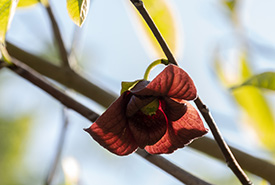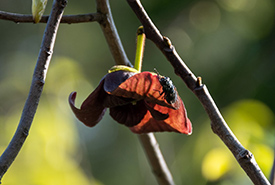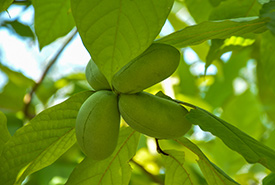April showers bring May flowers, and May flowers bring…flies?

A pawpaw flower (Photo by Andrea J. Moreau)
Come spring, natural spaces are always buzzing with activity. The warmer weather and sweet floral scent carried on the wind attract people and prospective pollinators alike.
I was no exception to this rule on one late May afternoon, excitedly heading out for a walk with my camera bag slung over my shoulder. Eventually, I came upon a small grouping of trees with sparse leaves and deep red flowers. A marker in the soil beneath the trees told me their name: Asimina triloba, or pawpaw.
The flowers were what first captured my attention, due to their distinct leathery texture. When I leaned in to take a closer look, I noticed that many insects also seemed to enjoy them.
However, these were not the bees or butterflies I had seen on other flowers, but flies! Most of us are aware of the important roles that pollinators play, including supporting genetic diversity and the reproduction of most flowering plants, in turn bringing us much of the food on our plates. Despite this, we tend to overlook the importance of less sightly pollinator species, including beetles, bats, wasps and flies.

A pawpaw flower with a fly on it. (Photo by Andrea J. Moreau)
Flies are crucial pollinators here in Canada, as they can withstand cooler temperatures than other pollinator species. They are also the most diverse order of insects in the country, with 9,620 different fly species in Canada so far! They exhibit equally diverse pollinating habits, often visiting plants that bees do not. Unfortunately, flies tend to get a bad rap, perceived as unclean pests due to the preference of some for feasting and laying their eggs on decaying organic matter. However, this happens to be exactly what makes them the perfect pollinators for the pawpaw tree!
Pawpaws are exclusively pollinated by flies and beetles, who are drawn to their flowers due to their slightly rotten odor and meat-like appearance. In just a few short months, with the help of these pollinators, the flowers are transformed into the largest fruit native to North America. They are also the only North American member of the tropical custard apple family and have a flavour that has been likened to mango, banana and pineapple, with a custard-like consistency.

Pawpaw fruit (Photo by Andrea J. Moreau)
So why have so many of us never heard of this plant? Unfortunately, the pawpaw is listed as vulnerable in Ontario and is not found elsewhere in Canada. Most pawpaw populations are found in the wild, as they are not mass cultivated due to their very short shelf life and are best eaten fresh off the tree. Pawpaw trees are also self-infertile, meaning that at least one other tree needs to exist nearby for successful pollination to occur.
Currently, pawpaw populations in Ontario are limited to the Carolinian zone, the northernmost area where forests are dominated by deciduous trees. Despite thriving in Ontario since the last ice age (when it was a favourite snack of the giant sloth and other megafauna), and having a rich history of stewardship and use by Indigenous Peoples, the pawpaw’s habitat is threatened by rapid deforestation and urbanization. Today, Carolinian forest ecosystems only cover about 11 per cent of the land they once did.
So, all of this is to say that flies have a very important role to play in conserving this unique species, and so do we! Pawpaws are just one of many plant and animal species that rely on forest ecosystems, and we can all support the conservation and restoration of these unique natural spaces. Oh, and next time you see a fly, remember that it might be on its way to ensure the future of a vulnerable species!
The 2023 Conservation Intern Program in Ontario is proudly supported by 407 ETR.


